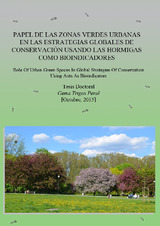Papel de las zonas urbanas en las estrategias globales de conservación usando hormigas como bioindicadores
Role of Urban Green Spaces in Global Strategies of Conservation Using Ants As Bioindicators
Autor
Trigos Peral, Gema
Director/es
Reyes López, J.Editor
Universidad de Córdoba, UCOPressFecha
2015Materia
BioindicatorsAnts
Parks
Biodiversity
Urban Green Spaces
Bioindicadores
Hormigas
Córdoba (España)
Parques
Zonas verdes urbanas
METS:
Mostrar el registro METSPREMIS:
Mostrar el registro PREMISMetadatos
Mostrar el registro completo del ítemResumen
Taken into account the role ants can play as bioindicators, we carried out a 10-year
study in 9 different urban parks in Córdoba (Andalusia, Spain), in order to find out how
habitat features affect the abundance and species richness of ants on small and large
scales.
Starting with a faunal study of the myrmecofauna present in each of the parks used in
the study (using pitfall traps, as main method, as well as Berlese and direct search), an
analysis was carried out to know the influence of the age and the distance from natural
and seminatural areas on the biodiversity in urban gardens. Also, 16 different features
present in the surrounding microhabitat of the pitfall traps (such as presence of tree or
shrubs, stones and leaf litter…) were analysed in order to establish a relationship
between these variables and the species of ants found in each pitfall trap taking into
account the effect of the invasive ant Linepithema humile on the other species. Once
the relationship with the microhabitat was known, the effect of the climate features as
determining factors of the myrmecofauna occurring in urban parks was also studied,
taking chance to use the weather station installed on the Campus of Rabanales.
Finally, the effect of the features of macrohabitat, such as canopy cover and humidity,
on the ant community were assessed.
As expected, due to the specificity of this bioindicator group, the biodiversity of ants
present in urban gardens is totally dependent on microhabitat and climate features, as
well as is dependent on the age an location of the park, even in damped ecosystems
such as urban parks, whereas the effect of the macrohabitat is almost imperceptible.

